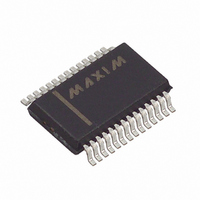MAX7300AAI+ Maxim Integrated Products, MAX7300AAI+ Datasheet - Page 6

MAX7300AAI+
Manufacturer Part Number
MAX7300AAI+
Description
IC I/O EXPANDER I2C 28B 28SSOP
Manufacturer
Maxim Integrated Products
Datasheet
1.MAX7300AAI.pdf
(24 pages)
Specifications of MAX7300AAI+
Interface
I²C
Number Of I /o
20
Interrupt Output
Yes
Frequency - Clock
400kHz
Voltage - Supply
2.5 V ~ 5.5 V
Operating Temperature
-40°C ~ 125°C
Mounting Type
Surface Mount
Package / Case
28-SSOP
Operating Supply Voltage
2.5 V to 5.5 V
Power Dissipation
727 mW
Operating Temperature Range
- 40 C to + 125 C
Input Voltage
1.65 V to 1.75 V
Maximum Clock Frequency
400 KHz
Mounting Style
SMD/SMT
Output Current
10 mA
Output Voltage
1.8 V
Bus Frequency
400kHz
No. Of I/o's
28
Supply Voltage Range
2.5V To 5.5V
Digital Ic Case Style
SSOP
No. Of Pins
28
Termination Type
SMD
Rohs Compliant
Yes
Filter Terminals
SMD
Ic Function
I/O Expander
Leaded Process Compatible
Yes
Lead Free Status / RoHS Status
Lead free / RoHS Compliant
2-Wire-Interfaced, 2.5V to 5.5V, 20-Port or
28-Port I/O Expander
The MAX7300 general-purpose input/output (GPIO)
peripheral provides up to 28 I/O ports, P4 to P31, con-
trolled through an I
ports can be configured to any combination of logic
inputs and logic outputs, and default to logic inputs on
power-up.
Figure 1 is the MAX7300 functional diagram. Any I/O port
can be configured as a push-pull output (sinking 10mA,
sourcing 4.5mA), or a Schmitt-trigger logic input. Each
input has an individually selectable internal pullup resis-
tor. Additionally, transition detection allows seven ports
(P24 to P30) to be monitored in any maskable combina-
tion for changes in their logic status. A detected transi-
tion is flagged through a status register bit, as well as an
interrupt pin (port P31), if desired.
The port configuration registers individually set the 28
ports, P4 to P31, as GPIO. A pair of bits in registers
0x09 through 0x0F sets each port’s configuration
(Tables 1 and 2).
The 36-pin MAX7300AAX and 40-pin MAX7300ATL
have 28 ports, P4 to P31. The 28-pin MAX7300ANI,
MAX7300AAI, and MAX7300ATI have only 20 ports
available, P12 to P31. The eight unused ports should
be configured as outputs on power-up by writing 0x55
6
28 SSOP
5–24
2, 3
_______________________________________________________________________________________
25
26
27
28
—
—
—
1
4
28 TQFN
27, 28
2–21
PAD
26
—
—
22
23
24
25
1
PIN
2
C-compatible serial interface. The
36 SSOP
Detailed Description
5–32
2, 3
33
34
35
36
—
—
—
1
4
1–10, 12–19,
37, 38, 39
11, 20, 31
40 TQFN
21–30
PAD
36
40
32
33
34
35
—
P 12–P 31
EXPOSE
P4–P31
NAME
D PAD
GND
ISET
N.C.
SDA
AD0
SCL
AD1
V+
Bias Current Setting. Connect ISET to GND through a resistor
(R
Ground
Address Input 0. Sets device slave address. Connect to either GND,
V+, SCL, SDA to give four logic combinations. See Table 3.
I/O P or ts. P 12 to P 31 can b e confi g ur ed as p ush- p ul l outp uts, C M O S -
l og i c i np uts, or C M O S - l og i c i np uts w i th w eak p ul l up r esi stor .
I/O P or ts. P4 to P31 can be configured as p ush- p ul l outputs, CMOS-
logic inputs, or CMOS-logic inputs with weak pullup resistor.
Not Connected.
I
I
Address Input 1. Sets device slave address. Connect to either GND,
V+, SCL, SDA to give four logic combinations. See Table 3.
Positive Supply Voltage. Bypass V+ to GND with minimum 0.047µF
capacitor.
Exposed Pad on Package Underside. Connect to GND.
2
2
C-Compatible Serial-Data I/O
C-Compatible Serial-Clock Input
ISET
) value of 39kΩ to 120kΩ.
to registers 0x09 and 0x0A. If this is not done, the eight
unused ports remain as floating inputs and quiescent
supply current rises, although there is no damage to
the part.
The MAX7300 offers 20 or 28 I/O ports, depending on
package choice. Two addressing methods are avail-
able. Any single port (bit) can be written (set/cleared)
at once; or, any sequence of eight ports can be written
(set/cleared) in any combination at once. There are no
boundaries; it is equally acceptable to write P0 to P7,
P1 to P8, or P31 to P38 (P32 to P38 are nonexistent, so
the instructions to these bits are ignored).
When the MAX7300 is in shutdown mode, all ports are
forced to inputs, and the pullup current sources are
turned off. Data in the port and control registers remain
unaltered, so port configuration and output levels are
restored when the MAX7300 is taken out of shutdown.
The MAX7300 can still be programmed while in shut-
down mode. For minimum supply current in shutdown
mode, logic inputs should be at GND or V+ potential.
Shutdown mode is exited by setting the S bit in the con-
figuration register (Table 8).
Register Control of I/O Ports
FUNCTION
Across Multiple Drivers
Pin Description
Shutdown











